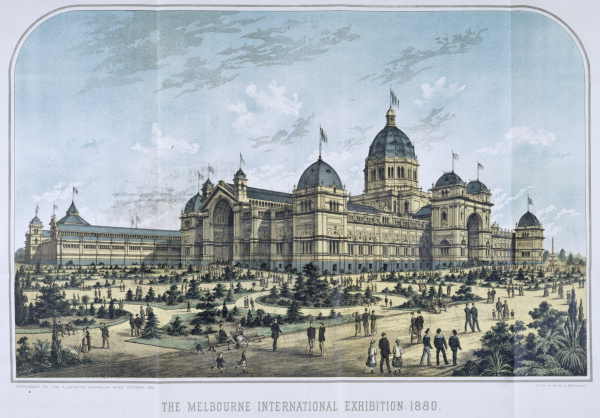April 2023
The Royal Exhibition Building is perhaps Melbourne’s most historic building. Constructed in 1880 as the venue for the great Melbourne International Exhibition, it was eight years later used for the even larger Centennial International Exhibition. These two grand events put the flamboyant gold-rich ‘Marvellous Melbourne’ on the international map in the late nineteenth century. The building was also the venue for the opening of Australia’s first Federal Parliament after federation in 1901, and the inauguration of Melbourne as the nation’s first capital. It was from the flagpole on its dome that the new Australian flag was first flown in 1901.

In 2004 the Australian Government nominated the site for World Heritage listing, arguing that: ‘The Royal Exhibition Building in its original garden setting is the most authentic remaining example of an in situ Palace of Industry from a significant international exhibition’. The eminent UK historian, Professor David Cannadine wrote: ‘There is nothing like it anywhere else in the world today’. UNESCO and the International Council on Monuments and Sites agreed, and today the Royal Exhibition Building and its surrounding Carlton Gardens is Australia’s first and Melbourne’s only World Heritage cultural site.
In seeking World Heritage listing the Australian Government promised a buffer zone around the Carlton Gardens. In this zone, ‘all planning policies [would] discourage the demolition of Victorian-era buildings and require any development to enhance heritage values’. But in 2007, when the buffer zone (now known as the World Heritage Environ Area, or WHEA) was proclaimed, it was cut back, and half of what was left was weakened by being deemed an area of lesser sensitivity. This made possible aberrations like the 60-story twin tower at the corner of Exhibition and La Trobe Streets which now dwarfs the Royal Exhibition Building and overwhelms the Gardens.
Every seven years, the management plan for the World Heritage site must be reviewed, and such a review has been underway over the past few years. From the beginning the RHSV has been involved in this process, advocating for greater protection of the site and making a number of submissions. This has been done in conjunction with other organization such as the National Trust and the Friends of the Royal Exhibition Building and Carlton Gardens. In April 2020 the RHSV was designated a key stakeholder and invited to participate in a review of the WHEA.
In early 2020, an excellent discussion paper produced by consultants on the WHEA Strategy Plan was released for public consultation. This clearly identified the many deficiencies of the current system of controlling development in the WHEA, and canvassed a number of positive solutions. After a period of public consultation, a Draft Strategy Plan (DSP) for the WHEA was released that recommended a number of positive changes, which the RHSV strongly supported. There were several main proposals:
First, the DSP recommended the removal of the distinction between the Area of Greater Sensitivity and the Area of Lesser Sensitivity, so that the WHEA was managed as one buffer zone. It was the introduction of this distinction in 2009 that made possible the construction of the skyscrapers that threaten the World Heritage values of the site on its southern boundary.
Second the DSP recommended that the views to the dome of the Royal Exhibition Building needed to be protected, as well as the views from the recently reconstructed viewing platform at the dome. While high-rise development has been allowed to encroach into the WHEA to the south, the recommendations of the DSP would maintain the character of the vistas from the dome in other directions, which for the most part retain a form and appearance close to what existed at the time of the building’s construction in 1880.
Third the DSP proposed the extension of the WHEA boundaries to the south, west and east. To the south it recommended the inclusion of the area bounded by LaTrobe, Russell, Victoria and Exhibition streets. To the west it proposed including properties fronting the west side of Drummond Street. To the east it recommended that the WHEA include the east side of the Fitzroy Street road reserve. The RHSV had proposed that this extension to the east should go further and incorporate properties on each side of Gertrude Street between Fitzroy and Brunswick Streets.

Image credit: Shutterstock (still from a video), Spotmatic Ltd.
What was missing from the DSP however was the question of effective governance of the World Heritage site as a whole. The RHSV was concerned that there was no entity that represented the World Heritage site as a whole, and which could act as a champion for the site and advocate for the maintenance of its World Heritage values without fear or favour.
In early 2022 a new draft document was released, called the Steering Committee Strategic Vision 2022-25. The RHSV fully supports this document, which if implemented fully would result in significant strengthening of the protection of this important heritage site. It is a first step toward giving the World Heritage Steering Committee the means to achieve its stated mission to ‘protect and communicate the diverse heritage values of the Royal Exhibition Building and Carlton Gardens, and advocate for financial investment and sustained management of the site and its surrounds for all communities, now and into the future’.
On 28 July 2022, a major milestone was reached when the then Minister, Hon. Lizzie Blandthorn, gazetted the extended boundaries for the WHEA. The new boundaries were consistent with the RHSV’s 2020 submission and restored the boundary as originally promised to UNESCO.
The World Heritage Management Plan has now been fully revised, and the RHSV strongly supports the new measures that it will put in place. The one remaining concern however is the issue of governance and the need to strengthen the World Heritage Steering Committee. The RHSV believes that in its present form the committee is not strong enough to achieve its objectives. The RHSV strongly recommends:
- A significant strengthening of the Steering Committee so as to create a fully-funded ‘single institution’ (in the UNESCO meaning of the term), centralising an overview of the Royal Exhibition Building and Carlton Gardens World site;
- Major reform of the Steering Committee by the inclusion of new members;
- Making the Executive Director of Heritage Victoria a determining referral authority for the WHEA, with a trigger for referral.
Given the significance of the Royal Exhibition Building and Carlton Gardens site and its importance for Melbournians and visitors alike, the RHSV believes that the effective conservation of it and its World Heritage Environs Area places the highest obligation imaginable on the Melbourne and Victorian planning authorities. The revised World Heritage Management Plan will provide strengthened measures to meet these high expectations and responsibilities, but its effective implementation will require a strengthening of the World Heritage Steering Committee.
To read the RHSV response of September 2021 to the WHEA Draft Strategy Plan click here
To read the RHSV submission to the Department of Environment in August 2021 click here
To read the RHSV response of April 2022 to the World Heritage Steering Committee’s Draft Strategic Vision click here
To read the RHSV’s submission of February 2023 to the Royal Exhibition Building and Carlton Gardens Review click here

 239 A'Beckett Street Melbourne, Victoria, 3000
239 A'Beckett Street Melbourne, Victoria, 3000  03 9326 9288
03 9326 9288  office@historyvictoria.org.au
office@historyvictoria.org.au  Office & Library: Weekdays 9am-5pm
Office & Library: Weekdays 9am-5pm

